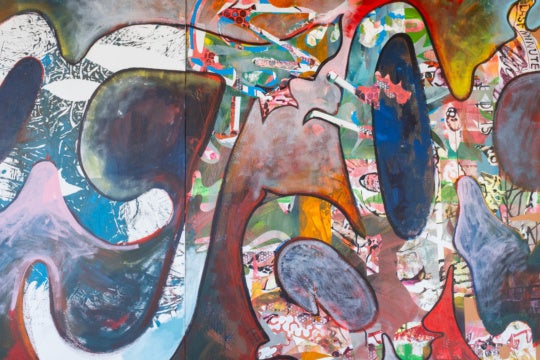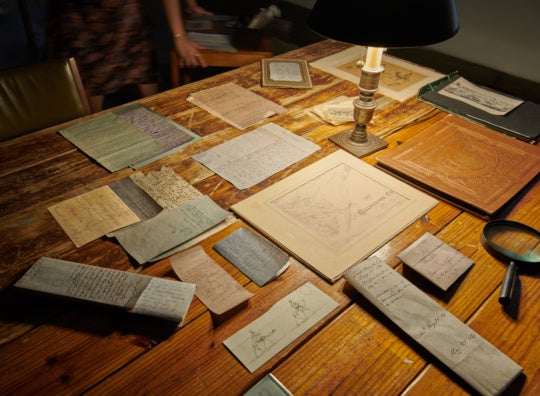
The Spoleto season in Charleston is a magical time. For three weeks the city is flooded with performers of all stripes and tourists looking to ride the wave of Spoleto Festival USA. School is out for the summer, Memorial Day opens the beach season, and it’s not even beastly hot yet. As an uprooted Charlestonian, I treasure the opportunity to go back home each year at the end of May. It’s become a tradition to try out the latest hot restaurants and pick out tickets to a few performances. I’m partial to the jazz concerts at the Cistern since it involves sitting outside underneath a canopy of live oaks in the heart of downtown with the Greek Revival facade of Randolph Hall as a perfect backdrop for the performers. Or there’s the charm of chamber music concerts, plays, and operas at the Dock Street Theatre, one of the oldest theaters in the US, where I watched plays as a child on school field trips. And I’ve caught some wonderful modern dance performances over the years; this year I jumped at the chance to see Robert Rauschenberg and Laurie Anderson’s collaborations with the Trisha Brown Dance Company.
Spoleto brings the best of the performing arts to Charleston, but for years it has struggled when it comes to presenting the visual arts. A defining moment was the 1991 “Places with a Past” exhibition, which attempted to match the quality of the performing arts programming by inviting 18 internationally known artists and artist teams to make work in Charleston. Though widely praised in the national art press, the exhibition was highly controversial at the local level and publicly rejected by the festival’s founder. Even when amends were made and the key personnel returned for “Evoking History” (2001-08), it was clear that Spoleto was backing off of visual art. Piccolo Spoleto—or “little” Spoleto, the city’s response to the official festival—might have picked up the slack, but its mission was to focus on regional and more accessible art and its exhibitions did not match the high-profile avant-garde aspect of “Places with a Past.” Into this void stepped the Halsey Institute of Contemporary Art, a gallery at the College of Charleston. Under the leadership of director Mark Sloan, the gallery has presented shows that rival Spoleto’s offerings. While Spoleto has benefited from this in the past by adopting the Halsey’s shows as part of their own programming, the gallery is now working under the banner of Piccolo Spoleto for its latest offering, an exhibition of recent work by New York-based artist Alyson Shotz.

“Force of Nature” features five projects in the main gallery space and five more in the smaller side gallery. A large-scale kaleidoscopic image, Emergent Structure (2014, latex print on vinyl), greets visitors with lots of glowing forms against a dark background. Drawn to its opalescent light, one starts to make out the beads, netting and flowerlike forms in the digital print. The imagery is compiled from various bits of Shotz’s artworks, including beaded and magnetic sculptures and animations. The flowers turn out to be the ceramic folds of the Recumbent Folds series, for instance. The mural serves as an introduction to Shotz’s work, though the aesthetic is much more Baroque glam than the more subtle minimalist aesthetics that dominate the rest of the show.
Invariant Interval #4 steals the show, hanging from the ceiling of the main room like the blue whale that dominates the Hall of Ocean Life at the American Museum of Natural History in New York (2013, stainless-steel wire, aluminum collars, and glass beads). At 20 feet by 30 feet, it is suspended from thin wires or monofilament so that it floats in space. The curvilinear form is made of stainless steel wire covered in glass beads that catch the sunlight coming in through a side window, the whole sparkling against the burnt sienna floor. The diamond pattern of the wire recalls netting, and the shape bulges and contracts as if the material has been stretched out in some spots and smushed together in others. The wire defines an elongated oval space, offering a lesson in volume, but photographs tend to flatten the effect.

Also strong is a nearby wall piece made of white string stretched across nails, White Fold Section 2 (2015, wet-spun linen thread and nails). The shape looks like a diagram of fabric folded into a pinwheel shape, but is actually the result of playing with a plane in the animation program Maya. The distortion and twisting that happened in the animation was then translated into the threads that now denote the lines of the original grid. Painstakingly connected with thread from nail to nail, the virtual grid is made all too physical. The patterns are complicated by cast shadows. Upon inspection, one is aware of the confusion that results from reading the changing distance between nails as folds. Now those folds inhabit only one plane—the few inches between the string and wall. But like Invariant Interval #4, this is lost in the photograph, which gives the optical illusion of depth back to the folds.
Folds are a recurrent theme in the exhibition, especially in the second gallery. Five black sculptures of folds, Black Folds (2014, painted aluminum), are displayed on a low white platform. These speak nicely with framed photographs of crumpled paper on the opposite wall, made by photographing crumpled paper and then crumpling the resulting photograph. Recent photorealist painting has fallen hard for the trick of depicting folds and crumples on a flat surface, but Topographic Iteration takes this a step further as the depicted folds both complement and contradict the real ones. A series of prints on one wall, Sequent (2013 portfolio of five color aquatints with collagraph embossing), tracks the sequence of diagonal folds applied to a piece of paper by lightening the value of one color (see video of its creation here). Finally, a reclaimed wood table plays its rough texture against five porcelain pieces from the series Recumbent Folds (2013, unglazed porcelain, reclaimed wood, and steel). These round vessels are deformed by dropping the wet clay from various heights. Gravity decides the form of the resulting slumped over vessel, speaking the poetry of chance.

The sequencing of images in Sequent visualizes the progression of time involved in the process of folding, and time is explored as well in the larger works where the viewer must walk around the piece or watch its progression. A wall of mirrored strips is funhouse fun. Frames Per Second is placed next to a window so that the light shimmers off the reflected bodies broken up into shards and slivers as you walk down its 21-foot expanse. The title refers to the frame rate used in movies, with 24 frames per second being the current standard. The strips could represent one frame each, thus carving the movement that passes them into the kind of individual frames that were the basis of Eadweard Muybridge’s historic experiments with stop-motion photography. While the resulting fractured images of the room are interesting on their own, it really calls out for dramatic selfies with its disco ball effect. In a nice segue, this leads one directly to Shotz’s stop motion animation film The Bedroom, Time Lapse (2014, projected animation).
The Bedroom, Time Lapse is projected from ceiling to floor on the back wall of a curtained-off space. We see a bedroom as sunlight pours in through a double casement window on the far end. Time-lapse photography follows the light pattern cast onto the wall by the window’s mullions. This rectangle of light circumnavigates the room until darkness falls. Shotz’s video, which was made in three 8-minute segments. is a minimalist study of the slight variations in this cycle of light as months change and seasons pass. The only clue to the progression of the calendar is the varying length and level of the light’s orbit around the room; otherwise, no clues, such as trees, are visible outside the one window.
The bedroom is based on Vincent van Gogh’s painting The Bedroom (1889) as well as the bedroom in Stanley Kubrick’s movie 2001: A Space Odyssey. Shotz replaces van Gogh’s rustic furnishings with similar items made of metal that recall institutional settings. A landscape painting hanging above a clothes rack in the van Gogh is replaced by a convex mirror; the paintings on the wall above the bed are replaced by mirrors that reflect the light. Van Gogh’s painting was about the calmness that he associated with the colors that he chose (such as the incongruous mint green used on the floorboards and the lavender-blue walls), but Shotz’s room is not about color. A simple white sheet covers the bed.

To make the video, Shotz collaborated with Todd Akita on an animated segment that has a black puddle creeping into the room from the corners of the floor. Musician Nasheet Waits provided the sound track. Simple taps on cymbals accompany the darkening of the room, and a piano plays as the room fills with water. The level of the water rises, but never goes above the plane of the bed. Then the water level slowly descends and we are back to a dry room, sometimes with watery reflections of the window on the floor.
Later, cymbals roar as white streaks move in diagonal lines through the sky outside the window—perhaps passing jets? As the light cycle repeats about once a minute, the video draws the viewer’s attention to the small differences, to events such as the passing jets. The effect is meditative. I started to notice the murmur of voices at the front desk, floating through the gallery into the installation space. An imitation cicada sound reminded me of the actual cicada sound that I miss desperately when I am not in Charleston.
The series Imaginary Sculptures puts this newfound awareness to work. Recalling Lawrence Weiner’s conceptual statements, the series comprises white steel plaques bearing cursive text that are suggestions for sculptures, such as “a sculpture made of wind,” “a sculpture made of flour, submerged in oil,” or “a sculpture made of a cloud.” The gambit of such work is that reading them immediately leads to unique mental images. “A sculpture made of flour, submerged in oil” makes me think of fried food and the sound of a fry basket descending into the oil. “A sculpture made of a cloud” brings back memories of lying on my back as a kid, looking up at the clouds floating in a big blue sky. Yes, it may be derivative of Weiner, but it’s a charming variation.
On first viewing, the variety of work in the exhibition can be confusing—digital manipulation, minimalist sculpture, conceptual texts, process art and photography. It’s the themes of time and space that tie it all together. The rhetoric of the promotional materials suggests connections to scientific concepts of time and space, and while Shotz has admitted such an interest in interviews, you don’t need to know any science or math to appreciate the work. What’s important is to slow down and become aware of your own experience. Once your perception has been fine-tuned, you’ll start to notice other changes. Shotz gets the last word in with Progression 2 by applying rotating oval rings (2014, vinyl etchings) to the windows outside the gallery. Our normal view of the city has been interrupted by her modification, just as her whole body of work aims to interrupt our perception.
“Alyson Shotz: Force of Nature” is on view at the Halsey Institute of Contemporary Art through July 11.
Rebecca Lee Reynolds is an assistant professor in the department of fine arts at the University of New Orleans, where she teaches art history.




